Toden Arakawa Line
The Toden Arakawa Line (都電荒川線, Toden Arakawa-sen), branded as the Tokyo Sakura Tram (東京さくらトラム, Tōkyō Sakura Toramu),[1] is a hybrid light rail/tram line in Tokyo, Japan, operated by the Tokyo Metropolitan Bureau of Transportation (Toei). The Arakawa Line is the sole survivor of Tokyo's once-extensive Tokyo Toden streetcar system. It is one of the only two tram lines in Tokyo, besides the Tokyu Setagaya Line.
| Toden Arakawa Line | |
|---|---|
 | |
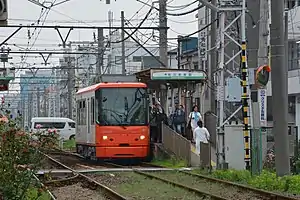 A Toei 8800 series tram at Arakawa-shakomae in September 2014 | |
| Overview | |
| Other name(s) | Tokyo Sakura Tram |
| Native name | 都電荒川線 |
| Owner | Tokyo Metropolitan Bureau of Transportation (Toei) |
| Locale | Tokyo |
| Termini | |
| Stations | 30 |
| Service | |
| Type | Light rail and streetcar |
| History | |
| Opened | 1911 (Ōji Electric Tram Company, Otsuka-ekimae - Asukayama) 1974 (Arakawa Line) |
| Technical | |
| Line length | 12.2 km (7.6 mi) |
| Track gauge | 1,372 mm (4 ft 6 in) |
| Electrification | 600 V DC overhead catenary |
Station list
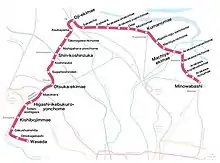
All stations are located in Tokyo.
| No. | Station | Japanese | Distance (km) | Transfers | Location | |
|---|---|---|---|---|---|---|
| Between stations |
Total | |||||
| SA01 | Minowabashi | 三ノ輪橋 | - | 0.0 | H Tokyo Metro Hibiya Line (Minowa: H-20) | Arakawa |
| SA02 | Arakawa-itchumae | 荒川一中前 | 0.3 | 0.3 | ||
| SA03 | Arakawa-kuyakushomae | 荒川区役所前 | 0.3 | 0.6 | ||
| SA04 | Arakawa-nichōme | 荒川二丁目 | 0.4 | 1.0 | ||
| SA05 | Arakawa-nanachōme | 荒川七丁目 | 0.4 | 1.4 | ||
| SA06 | Machiya-ekimae | 町屋駅前 | 0.4 | 1.8 |
| |
| SA07 | Machiya-nichōme | 町屋二丁目 | 0.4 | 2.2 | ||
| SA08 | Higashi-ogu-sanchōme | 東尾久三丁目 | 0.3 | 2.5 | ||
| SA09 | Kumanomae | 熊野前 | 0.6 | 3.1 | NT Nippori-Toneri Liner (NT04) | |
| SA10 | Miyanomae | 宮ノ前 | 0.4 | 3.5 | ||
| SA11 | Odai | 小台 | 0.3 | 3.8 | ||
| SA12 | Arakawa-yūenchimae | 荒川遊園地前 | 0.3 | 4.1 | ||
| SA13 | Arakawa-shakomae | 荒川車庫前 | 0.5 | 4.6 | ||
| SA14 | Kajiwara | 梶原 | 0.4 | 5.0 | Kita | |
| SA15 | Sakaechō | 栄町 | 0.5 | 5.5 | ||
| SA16 | Ōji-ekimae | 王子駅前 | 0.5 | 6.0 |
| |
| SA17 | Asukayama | 飛鳥山 | 0.5 | 6.5 | ||
| SA18 | Takinogawa-itchōme | 滝野川一丁目 | 0.4 | 6.9 | ||
| SA19 | Nishigahara-yonchōme | 西ヶ原四丁目 | 0.4 | 7.3 | ||
| SA20 | Shin-koshinzuka | 新庚申塚 | 0.4 | 7.7 | I Toei Mita Line (Nishi-sugamo: I-16) | Toshima |
| SA21 | Kōshinzuka | 庚申塚 | 0.2 | 7.9 | ||
| SA22 | Sugamoshinden | 巣鴨新田 | 0.5 | 8.4 | ||
| SA23 | Ōtsuka-ekimae | 大塚駅前 | 0.5 | 8.9 | JY Yamanote Line (Ōtsuka: JY12) | |
| SA24 | Mukōhara | 向原 | 0.5 | 9.4 | ||
| SA25 | Higashi-ikebukuro-yonchome | 東池袋四丁目 | 0.6 | 10.0 | Y Tokyo Metro Yurakucho Line (Higashi-ikebukuro: Y-10) | |
| SA26 | Toden-zoshigaya | 都電雑司ヶ谷 | 0.2 | 10.2 | ||
| SA27 | Kishibojimmae | 鬼子母神前 | 0.5 | 10.7 | F Tokyo Metro Fukutoshin Line (Zoshigaya: F-10) | |
| SA28 | Gakushuinshita | 学習院下 | 0.5 | 11.2 | ||
| SA29 | Omokagebashi | 面影橋 | 0.5 | 11.7 | Shinjuku | |
| SA30 | Waseda | 早稲田 | 0.5 | 12.2 | ||
Rolling stock
- 7700 series (since 31 May 2016)[2]
- 8500 series
- 8800 series
- 8900 series (since 18 September 2015)[3]
- 9000 series
.jpg.webp) 7700 series tram 7701 in July 2016
7700 series tram 7701 in July 2016 8500 series tram 8502 in June 2003
8500 series tram 8502 in June 2003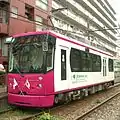 8800 series tram 8804 in September 2010
8800 series tram 8804 in September 2010 8900 series tram 8901 in September 2015
8900 series tram 8901 in September 2015 9000 series trams 9001 and 9002 in February 2009
9000 series trams 9001 and 9002 in February 2009
Former rolling stock
- 7000 series (1955 until 10 June 2017)[4]
- 7500 series
 7000 series tram 7015 in June 2009
7000 series tram 7015 in June 2009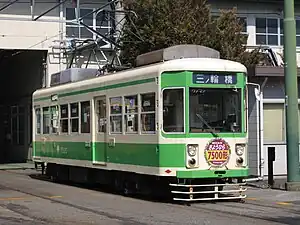 7500 series tram 7520 in March 2011
7500 series tram 7520 in March 2011
History
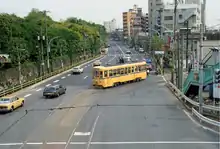
The line was originally constructed by the Ōji Electric Tram Company (王子電気軌道, Ōji-denki-kidō) as a part of their extensive network, with the oldest section still operating today opened in 1913. The line was at threat of being shut down along with the rest of Tokyo's streetcar system in the 1960s, but concerted opposition from residents prevented this and parts of lines 27 (Minowabashi-Akabane) and 32 (Arakawa-Waseda) were merged to form the line as it is today. The line was sold to the Tokyo Metropolitan Bureau of Transportation in 1974, which renamed it the Toden Arakawa Line.
The Toden Arakawa Line operates between the terminals at Minowabashi Station and Waseda Station. It runs along Meiji Street between Asuka-yama Station and Oji Eki-mae Station. Otherwise, it operates on its own tracks. Presently, single driver-operated cars make the 12.2 km (7.6 mi) trip in 50 minutes. The gauge is 1,372 mm (4 ft 6 in). The line is fully double-track, and draws 600 V electrical supply.
Two Toden Arakawa trams (one in revenue earning service, the other undergoing brake testing) collided on June 13, 2006 near the Minowabashi terminus, injuring 27 people.
Sights
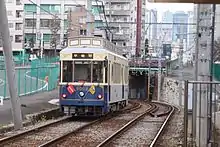
The Toden Arakawa Line operates in northern and eastern Tokyo outside the main tourist areas. The terminus at Minowabashi is near the historical site of Edo's red-light district Yoshiwara which features a completely covered shopping street, several blocks long, in the once common "Ameyoko" style (a shōtengai).
In literature
In Haruki Murakami's novel Norwegian Wood, protagonist Toru Watanabe takes the line to near Ōtsuka Station: "I sat in the last seat and watched the ancient houses passing close to the window. The tram almost touched the overhanging eaves.... The tram snaked its way through this private back-alley world."[5]
References
L.W. Demery, R. Forty, R. DeGroote and J.W. Higgins, Electric Railways of Japan (Interurbans- Tramways-Metros) Vol.1: Tokyo and Northern Japan. Light Rail Transit Association, 1983.
- 都電荒川線の愛称を決定しました! (in Japanese). Japan: Tokyo Metropolitan Bureau of Transportation. Retrieved 30 April 2017.
- 都電荒川線で7701号車が営業運転を開始 [Car 7701 enters service on Toden Arakawa Line]. Japan Railfan Magazine Online (in Japanese). Japan: Koyusha Co., Ltd. 31 May 2016. Retrieved 31 May 2016.
- 都電荒川線で8900形が営業運転を開始 [8900 series enter service on Toden Arakawa Line]. Japan Railfan Magazine Online (in Japanese). Japan: Koyusha Co., Ltd. 19 September 2015. Retrieved 19 September 2015.
- さようなら都電荒川線7000形 60年余の運行の歴史に幕 [farewell to Toden Arakawa Line 7000 series - closing the curtain on 60 years of service]. Nifty News (in Japanese). Japan: Nifty Corporation. 12 June 2017. Archived from the original on 12 June 2017. Retrieved 12 June 2017.
- p. 84, Vintage Books edition.
External links
- Tokyo Metropolitan Bureau of Transportation: Toden Arakawa Line (in Japanese)
- Toei Streetcar (Toden) Arakawa Line (in English)
- Nippori-Toneri Liner and Tokyo Sakura Tram station numbering (in Japanese)